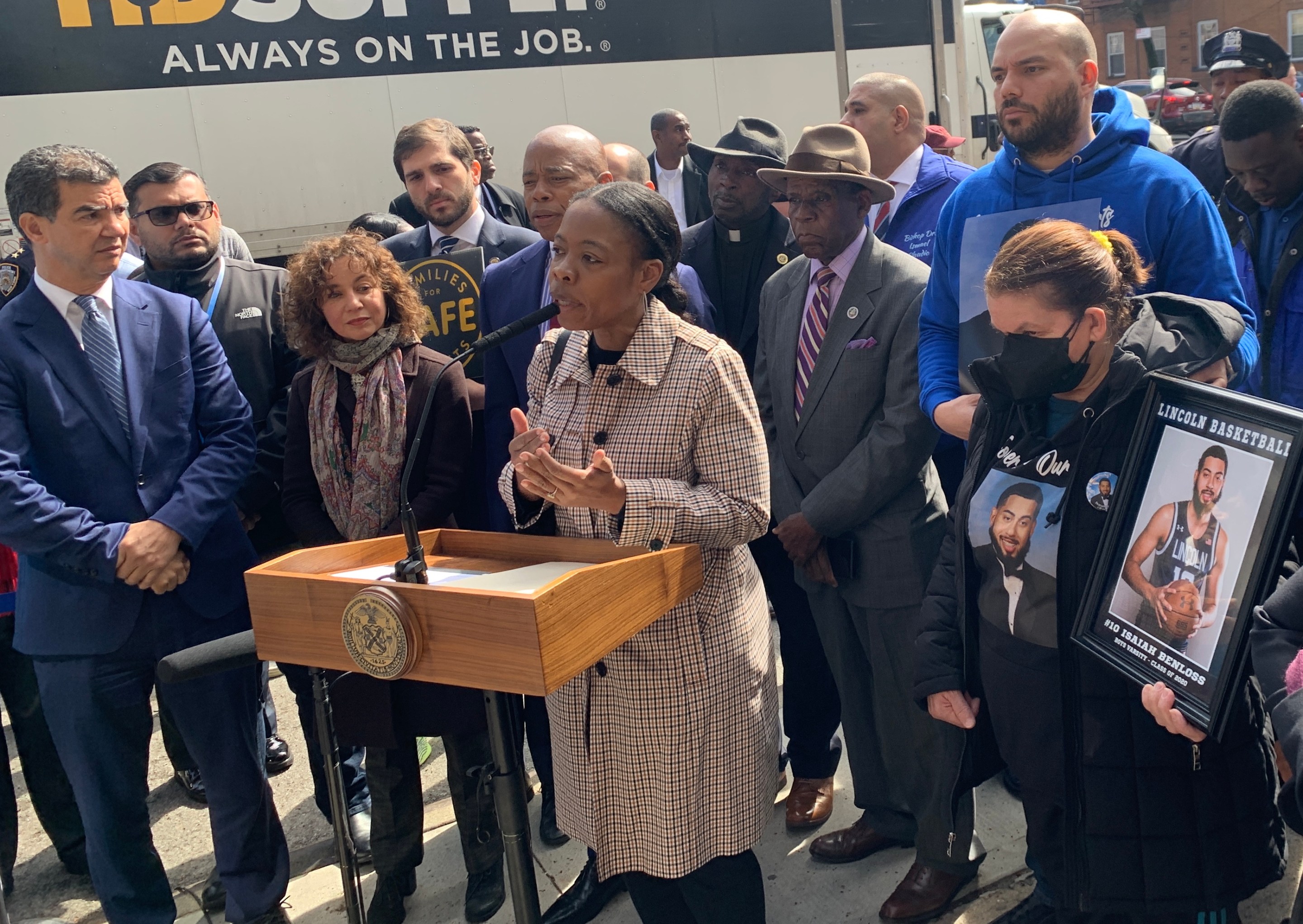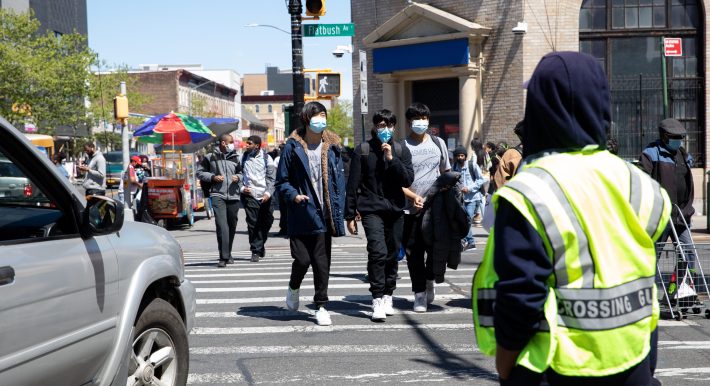Council Education Chair on Car-Free School Streets: ‘I Love It’
12:01 AM EDT on June 2, 2022

Rita Joseph speaking at a rally in support of expanding the city’s speed camera program in March 2022. Photo: Gersh Kuntzman
Few New Yorkers are more qualified to weigh in on Streetsblog's recent investigation into dangerous school streets than Brooklyn Council Member Rita Joseph — a vocal safe-streets advocate and a former teacher. Before joining the Council, she spent 22 years at Flatbush's P.S. 6, which is surrounded by what Streetsblog found to be some of the most dangerous school streets in the city. And Joseph has lost two former students to traffic violence. Now, the first-term lawmaker is uniquely poised to make a difference on the issue. Joseph holds the powerful post of Education Committee chair in the Council, where she could advance legislation to make school streets safer. Streetsblog spoke to Joseph about school streets last week; a transcript of the conversation is below, condensed and edited for clarity.

STREETSBLOG: Streetsblog analyzed city data on nearly one million car crashes and built a database of crashes that occurred near city public schools. We found that rates of car crashes and injuries are higher near schools than they are on other city streets on school days, and that school streets are even more dangerous when those school buildings have majority students of color or majority poor students. We also found that drivers have killed at least 24 children heading to or from school on foot or bike in New York City in the past decade. What are your thoughts on these findings?
RITA JOSEPH: As a parent — I still have an 11-year-old in school — that's alarming. As a former educator, that's even more alarming. 24 students killed — that's 24 sets of parents across the city every night that don't get to say goodnight to their child. So that bothers me. As the chair of the Education Committee, I have to talk to my team to find out what can we do to bring down these numbers so that no parent is without their child at night. I am extremely, extremely disturbed.
STREETSBLOG: Could you tell us about your personal connection to this issue?
JOSEPH: In 2009, it was by a school that I lost Kyle Francis, who was one of my students, whom I'd invested so much in. He was hit right by his school. It still stays with me today. And then we just lost another former student of mine, Isaiah Benloss. He was in a Lyft coming home, but he never made it home. We still have no idea who hit him — the driver who hit him got away with it. Isaiah was in a coma for nine months until he passed away last year. These occurrences break my heart over and over. I want to know, now that I'm in a position of leadership, what I can do on the Council to make sure that these numbers don't exist anymore.
STREETSBLOG: How did the deaths of these students of yours change your views about how we design our streets and public spaces, particularly around schools?
JOSEPH: We've designed streets all these years for cars — we need to start designing them with people in mind. If we have reliable public transportation and good streets, I'm sure people will use their cars less. I'm all for that. That's why in the Council we voted to keep school-zone speed cameras on 24 hours a day, seven days a week — to make sure that these occurrences are not happening. These numbers don't sit well with me. This Council has a lot of moms, and I'm sure my colleagues would agree.
STREETSBLOG: One city school building that we found had especially dangerous streets nearby is in your district: Erasmus Hall on Flatbush Avenue. There have been more injuries from car crashes outside it during student drop-off and pick-up hours in recent years than outside any other school building in the city. We spoke to a number of students there, and nearly all of them said they have almost been hit by cars while walking to or from school. One student told me she had little hope the city would do anything about the problem. What’s your reaction to all that?
JOSEPH: P.S. 6, where I taught, is next door to Erasmus Hall. A lot of my former students go there. Now I have to go meet with the student body and let them know that they have a champion and an ally in me. I want to make sure that they have a street that they can feel safe on when coming to school and going home.

STREETSBLOG: We also found that there are around 800 fewer crossing guards in the city now than there were three years ago. Guards we spoke to said no one wants the job because it’s dangerous and they get paid close to minimum wage.
JOSEPH: There's a huge crossing guards vacancy, and I'm sure it's our communities, Black and brown communities, that the city doesn't prioritize in assigning guards to locations. When I visited the Bronx as the chair of the Education Committee, I had principals telling me, “Council member, at three o'clock, I am the crossing guard.” It's dangerous, and it's a lot of women doing this work. At a Committee on Public Safety hearing, I told an NYPD official: "Maybe if you were paying these people living wages, you would have filled up the vacancies." Paying them living wages is one way, and making sure they feel safe is another.
STREETSBLOG: Safe streets advocates call for making school streets car free on school days, at least during drop-off and pick-up hours. What do you think of that idea?
JOSEPH: I love it. I would do it.
STREETSBLOG: Do you think the Council should pass new legislation to help keep kids safe outside schools? Are you considering introducing any legislation on this issue?
JOSEPH: I would definitely. This will definitely be something that I will be discussing with my colleagues.
After the interview, Streetsblog followed up with the Council member to ask what that legislation might be, and whether the city should do more to keep kids safe outside schools. She said:
JOSEPH: The city should absolutely do more to protect kids from traffic violence outside schools, and everywhere else for that matter. Even a single crash is one too many. There are so many steps that we can and should be taking. We need street redesigns. We need speed humps. We need to hold hit and run drivers accountable. Last and certainly not least, we need to improve service on public transit so that commuters get out of their cars and onto buses and the subway.
Before I talk about a potential future bill, I want to discuss two much-needed bills that have already been introduced. My bill, Int. 401, would mandate the installation of speed bumps on roadways adjacent to any park equal to or greater than one acre. Passing it would make our streets meaningfully safer for pedestrian, bikers, drivers and strap hangers alike. Int. 329, introduced by Council Member Selvena Brooks-Powers, would establish a reward for people who provide information leading to the apprehension, prosecution or conviction of a person who seriously injures or kills another individual in a hit-and-run accident. One of my former students was killed in a hit and run, so this is personal to me. The passage of both these bills would help protect our young people in real, meaningful ways.
Brooks-Powers, who chairs the Transportation Committee, did not respond to multiple requests to comment on dangerous school streets.
Jesse Coburn is an investigative reporter at Streetsblog. You can reach him at jesse@streetsblog.org / 917 283 2482.
Stay in touch
Sign up for our free newsletter
More from Streetsblog New York City
Report: Road Violence Hits Record in First Quarter of 2024
Sixty people died in the first three months of the year, 50 percent more than the first quarter of 2018, which was the safest opening three months of any Vision Zero year.
Street Sweepers Could Nab Illegal Parking Under State Bill
Smile for the street-sweeper!
Thursday’s Headlines: The Way of Water Edition
The "Blue Highways" campaign wants the mayor to convert a downtown heliport into a freight delivery hub. Plus more news.
Gotcha-Heimer! Anti-Congestion Pricing Jersey Rep. With a City Speeding Ticket Drove to Manhattan on Wednesday
New Jersey's most vociferous opponent of congestion pricing parked illegally and once got a speeding ticket.




